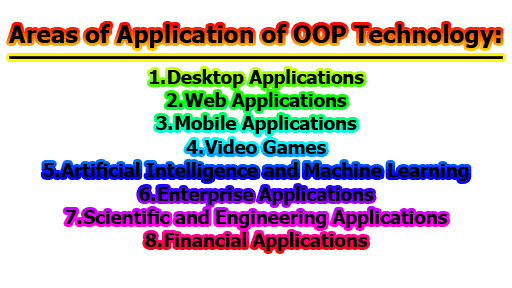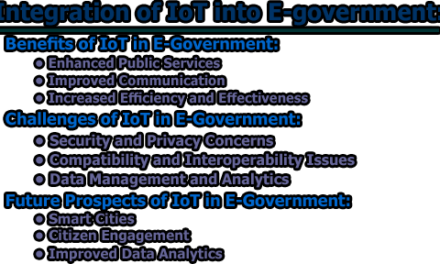Object Oriented Programming:
Object Oriented Programming (OOP) is a programming paradigm that focuses on the use of objects and classes to represent data and behavior. It is based on the concepts of objects, classes, inheritance, encapsulation, abstraction, and polymorphism. In this article, we are going to know about areas of application of OOP technology, and the benefits, and limitations of object-oriented programming.
Areas of application of OOP technology:
Object Oriented Programming (OOP) is widely used in a variety of application areas, including:
- Desktop Applications: OOP is used to develop desktop applications such as text editors, media players, and image editors.
- Web Applications: OOP is used to develop dynamic web applications such as e-commerce sites, social media platforms, and content management systems.
- Mobile Applications: OOP is used to develop native mobile applications for iOS and Android platforms.
- Video Games: OOP is used to develop video games, both for desktop and mobile platforms.
- Artificial Intelligence and Machine Learning: OOP is used to implement AI algorithms and models in applications such as computer vision, natural language processing, and recommendation systems.
- Enterprise Applications: OOP is used to develop enterprise applications such as customer relationship management (CRM) systems, human resource management (HRM) systems, and supply chain management (SCM) systems.
- Scientific and Engineering Applications: OOP is used in scientific and engineering applications to model complex systems, simulate physical processes, and analyze data.
- Financial Applications: OOP is used in financial applications such as trading systems, risk management systems, and accounting software.
Benefits of Object Oriented Programming:
Object Oriented Programming (OOP) has several benefits that make it a popular programming paradigm, including:
a. Encapsulation: Encapsulation helps to hide the implementation details of an object and provides a clear separation between the implementation and the user of the object. This makes it easier to maintain and modify the code, as changes to the implementation of an object do not affect other parts of the code.
b. Inheritance: Inheritance allows classes to inherit the properties and behaviors of other classes, making it possible to create new classes based on existing ones. This reduces the amount of code that needs to be written and makes it easier to create and maintain complex systems.
c. Polymorphism: Polymorphism allows objects of different classes to be treated as objects of a common base class, even if they have different implementations. This makes it possible to write code that can work with objects of different types, without knowing the exact type of the object.
d. Reusability: OOP makes it possible to reuse code by creating reusable objects and classes. This reduces the amount of code that needs to be written and makes it easier to maintain and update the code.
e. Abstraction: Abstraction is the process of hiding the details of an object and exposing only the essential features to the user. This makes it easier to understand and use the code and reduces its complexity of the code.
f. Modularity: OOP allows the code to be organized into objects and classes, making it possible to break down a complex system into smaller, more manageable components. This makes it easier to understand and maintain the code.
g. Scalability: OOP makes it easier to scale a system, as new objects and classes can be added or existing ones can be modified to meet the changing requirements of a system.
h. Improved maintainability: OOP makes it easier to maintain and update the code, as changes to an object do not affect other parts of the code. This makes it easier to fix bugs and add new features to a system.
Limitations of Object Oriented Programming:
There are several limitations of Object Oriented Programming (OOP), including:
a. Complexity: OOP can sometimes lead to more complex systems, especially when inheritance and polymorphism are used extensively.
b. Performance: OOP can have a performance overhead, especially when dealing with a large number of objects and complex inheritance hierarchies.
c. Over-engineering: OOP can encourage developers to over-engineer systems by creating classes for everything, resulting in systems that are difficult to maintain and understand.
d. Difficulty in modeling some problems: OOP may not always be the best approach for solving certain types of problems, particularly problems that don’t fit well into a class-based model.
e. Tight coupling: OOP can result in tight coupling between objects, making it difficult to make changes to one part of the system without affecting others.
f. Debugging and testing difficulties: OOP can make it harder to debug and test systems, particularly when dealing with inheritance and polymorphism.
g. Dependence on a specific programming language: OOP concepts are language-specific, and different programming languages may have different implementations of OOP. This can make it difficult to transfer OOP-based code from one language to another.
In conclusion, OOP is a powerful programming paradigm that provides a number of benefits to software development, including encapsulation, inheritance, and polymorphism. By organizing code into objects and classes, OOP makes it possible to write clear, modular, and maintainable code, and to build large and complex software systems with ease. Whether you’re a beginner or an experienced programmer, understanding OOP is an essential part of modern software development, and a valuable skill to have in today’s job market.

Assistant Teacher at Zinzira Pir Mohammad Pilot School and College










